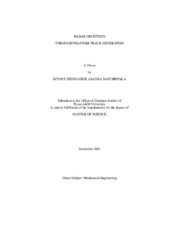| dc.contributor.advisor | Jayasuriya, Suhada | |
| dc.creator | Maithripala, Diyogu Hennadige Asanka | |
| dc.date.accessioned | 2006-04-12T16:03:46Z | |
| dc.date.available | 2006-04-12T16:03:46Z | |
| dc.date.created | 2005-12 | |
| dc.date.issued | 2006-04-12 | |
| dc.identifier.uri | https://hdl.handle.net/1969.1/3169 | |
| dc.description.abstract | This thesis presents a control algorithm to be used by a team of ECAVs (Electronic Combat
Air Vehicle) to deceive a network of radars through the generation of a phantom track.
Each ECAV has the electronic capability of intercepting and introducing an appropriate
time delay to a transmitted pulse of a radar before transmitting it back to the radar, thereby
deceiving the radar into seeing a phantom target at a range beyond that of the ECAV. A radar
network correlates targets and target tracks to detect range delay based deception. A team of
cooperating ECAVs, however, precisely plans their trajectories in a way all the radars in the
radar network are deceived into seeing the same phantom. Since each radar in the network
confirms the target track of the other, the phantom track is considered valid. An important
feature of the algorithm achieving this is that it translates kinematic constraints on the
ECAV dynamic system into constraints on the phantom point. The phantom track between
two specified way points then evolves without violating any of the system constraints. The
evolving phantom track in turn generates the actual controls on the ECAVs so that ECAVs
have flyable trajectories. The algorithms give feasible but suboptimal solutions. The main
objectives are algorithm development for phantom track generation through a team of cooperating
ECAVs, development of the algorithms to be finite dimensional searches and
determining necessary conditions for feasible solutions in the immediate horizon of the
searches of the algorithm. Feasibility of the algorithm in deceiving a radar network through
phantom track generation is demonstrated through simulation results. | en |
| dc.format.extent | 408450 bytes | en |
| dc.format.medium | electronic | en |
| dc.format.mimetype | application/pdf | |
| dc.language.iso | en_US | |
| dc.publisher | Texas A&M University | |
| dc.subject | Autonomous systems | en |
| dc.subject | Cooperative control | en |
| dc.subject | Optimization algorithms | en |
| dc.title | Radar deception through phantom track generation | en |
| dc.type | Book | en |
| dc.type | Thesis | en |
| thesis.degree.department | Mechanical Engineering | en |
| thesis.degree.discipline | Mechanical Engineering | en |
| thesis.degree.grantor | Texas A&M University | en |
| thesis.degree.name | Master of Science | en |
| thesis.degree.level | Masters | en |
| dc.contributor.committeeMember | Datta, Aniruddha | |
| dc.contributor.committeeMember | Parlos, Alexander | |
| dc.type.genre | Electronic Thesis | en |
| dc.type.material | text | en |
| dc.format.digitalOrigin | born digital | en |


